Module 21.1 Dialogues
Title
Dialogue 1: Naomi Johnson shops at a store
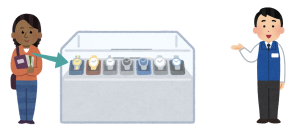
| Language |
Script and Translation
|
Japanese |
|
Romanization |
1 Jonson: Sumimasen, kono tokei wa ikura desu ka?
2 tenin: Sanzen en desu. 3 Jonson: Jaa, kono tokei o kudasai. 4 tenin: Hai, arigatou gozaimasu. |
English translation |
1 Johnson: Excuse me, how much is this watch?
2 Store clerk: This is 3,000 yen. 3 Johnson: Can I have this watch then? 4 Store clerk: Yes, thank you. |
Dialogue 1 Vocabulary
Dialogue 2: Naomi Johnson shops at another store and compares prices
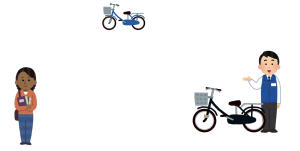
| Language | Script and Translation |
Japanese |
1 ジョンソン:すみません、その自転車はいくらですか。 |
Romanization |
1 Jonson: Sumimasen, sono jitensha wa ikura desu ka?
2 tenin: Hassen happyaku en desu. 3 Jonson: Ano jitensha mo hassen happyaku en desu ka? 4 tenin: Hai, sou desu. 5 Jonson: Jaa, are o kudasai. |
English translation |
1 Johnson: Excuse me, how much is that bicycle (near you)?
2 Store clerk: That is 8,800 yen. 3 Johnson: Is that bicycle (over there) also 8,800 yen? 4 Store clerk: Yes, it is. 5 Johnson: Please give me that one (over there) then. |
Dialogue 2 Vocabulary
| Japanese | Romanization | Kanji | English | |
| その+Noun | sono + noun | that + noun | ||
| じてんしゃ | jitensha | 自転車 | bicycle | |
| はっせん
はっぴゃくえん |
hassen
happyakuen |
8800えん (八千八百円) | 8,800 yen | |
| あれ | are | that | ||
| ください | kudasai | 下さい | please (give me) |
More Useful Words
Grammar Notes
| この noun, その noun, and あの noun |
この (kono), その (sono), and あの (ano) are words used to point at things or identify things.
In the case of これ (kore), それ (sore), and あれ (are), the noun is already built in each word.
However, in the case of この, その, and あの, each of these words has to be followed by a noun. It may be easier to consider この, その, and あの as the equivalent of “the” in English. “The” for identifying things has to be followed by a noun.
In English, there is only one “the” to point at a thing/person near the speaker, near the listener, and away from both the listener and the speaker.
However, there are three types of “the”‘ in Japanese. Pay special attention to how これ/この, それ/その, and あれ/あの are used in each pair of the sentences below.
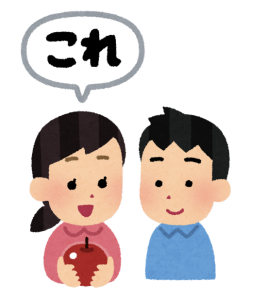 |
これは500円です。 |
| Kore wa 500 en desu. | |
| This (near me) is 500 yen. |
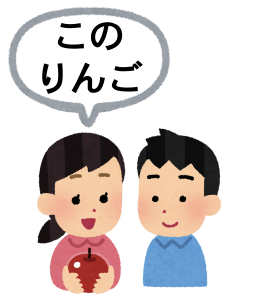 |
このりんごは500円です。 |
| Kono ringo wa 500 en desu. | |
| The apple (near me) is 500 yen. |
*これりんご (kore ringo; this apple near me) is an incorrect expression.
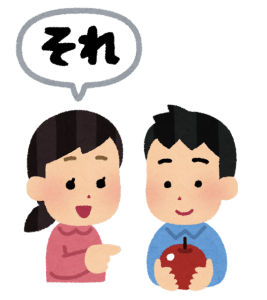 |
それは500円です。 |
| Sore wa 500 en desu. | |
| That (near you) is 500 yen. |
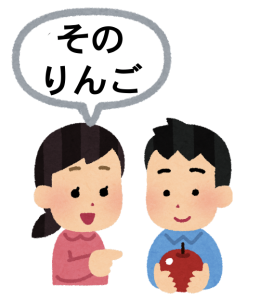 |
そのりんごは500円です。 |
| Sono ringo wa 500 en desu. | |
| The apple (near you) is 500 yen. |
*それりんご (sore ringo; that apple near you) is an incorrect expression.
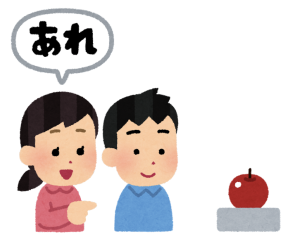 |
あれは500円です。 |
| Are wa 500 en desu. | |
| That (over there) is 500 yen. |
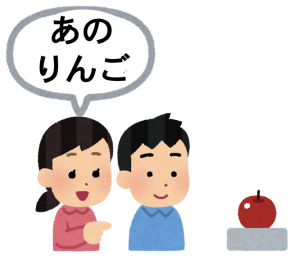 |
あのりんごは500円です。 |
| Ano ringo wa 500 en desu. | |
| The apple (over there) is 500 yen. |
*あれりんご (are ringo; that apple over there) is an incorrect expression.
とけい
てんいん
えん
くだ
じてんしゃ
